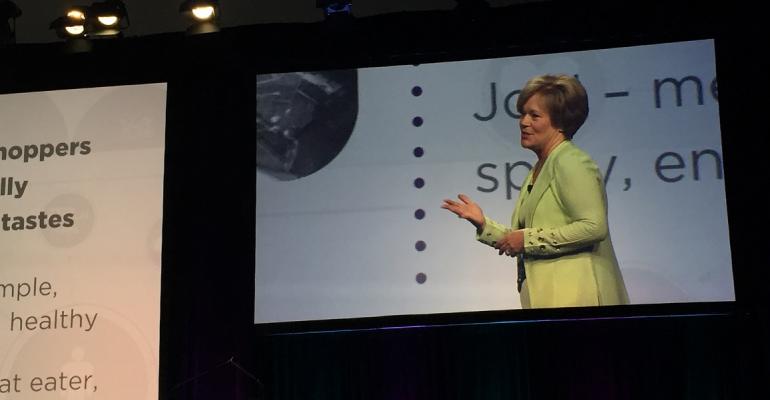Retailers seeking deeper consumer connections need to better understand how households today are sharing shopping roles, according to a presentation by Leslie Sarasin, president and CEO, Food Marketing Institute.
Citing data from FMI's latest U.S. Grocery Shopper Trends report, Sarasin outlined how this is playing out and why it's important to retailers. She spoke at a session during FMI Connect 2016 in Chicago.
One challenge is to help customers navigate shopping to address both their own needs and those of the household, which may not always be the same, she said.
"Retailers should aspire to assist their customers in both areas, helping them to meet the needs of the many and helping them satisfy their own personal needs," she said.
Among the data points Sarasin outlined were:
• 22 percent of all shoppers are from households that have a relatively clear 50-50 split in handling shopping duties.
• 58 percent of shoppers are "part of their household's food shopping team," which means they have "varying and shifting degrees of responsibility for grocery shopping."
• 31 percent of young Millennials are 50/50 shared shoppers, "some nine percentage points higher than the national average."
"No two households handle their split exactly the same way," she said. "In fact, as work situations change, budgets get revised, schedules are juggled ... household approaches to shared shopping may realign from week to week."
The details play out differently by generations as well. Matures, defined as 71 years and over, didn't come of age in a shared shopping environment, but more recently they are embracing this practice out of a sense of fairness, she said.
On the other end of the spectrum, Millennials show different motivations for sharing, and much of it is out of self-interest. Nearly 50% of younger Millennials like to share shopping to help indulge their individual tastes in food. These tastes were honed for Generation Y during extended periods of single living.
"Then, when they find themselves in a situation of dividing household responsibilities, they want to share in the grocery shopping as something of a defensive means of ensuring their own preferences aren't lost, ignored or dropped off the grocery list," she explained.
This type of sharing inevitably results in the need for communication within households, especially around typical choices involving taste, health and cost, she continued. The communication isn't always smooth or even civil, and retailers can play a role in helping to build bridges.
"As their trusted collaborator in the food shopping venture, food retailers are well positioned to prompt some of these conversations."
Sarasin said this can be accomplished through different platforms.
"What if you used your social media outlet as just that — a bit of social exchange with your customers by helping promote table talks?"
This includes "inviting couples to speak with each other and not at each other about their family food philosophy," she added.
Sarasin also cited the issues of health and wellness and multicultural shopping as important areas of focus for retailers.
Retailers continue to score high on the trust scale for food safety, she noted, but increasingly consumers are also exhibiting an "expanding consumer concept of wellness and the role of food within it."
She said 14% are seeking organic certification, 21% are interested in sources clearly committed to humane treatment of animals, and about 30% favor supporting the local economy in their shopping.
"Food retailers at the local level and farmers are consumers' most trusted allies on the food chain for health," she said. "This is a point we should not only celebrate, but also is a strength we must amplify.”
Turning to multicultural marketing, Sarasin said the Hispanic population in particular is growing quickly so retailers need enhance their understanding of its needs.
"In a decade, likely one in five of your customers will be Latino," she said. "A striking 58% of the Latino population is under the age of 33."
She urged retailers to "indulgent your Latino taste preferences" as these trends play out.
| Suggested Categories | More from Supermarket News |
 |
|
 |
|





